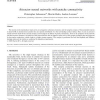Free Online Productivity Tools
i2Speak
i2Symbol
i2OCR
iTex2Img
iWeb2Print
iWeb2Shot
i2Type
iPdf2Split
iPdf2Merge
i2Bopomofo
i2Arabic
i2Style
i2Image
i2PDF
iLatex2Rtf
Sci2ools
101
Voted
IJON
2006
2006
Attractor neural networks with patchy connectivity
The neurons in the mammalian visual cortex are arranged in columnar structures, and the synaptic contacts of the pyramidal neurons in layer II/III are clustered into patches that are sparsely distributed over the surrounding cortical surface. Here, we use an attractor neural-network model of the cortical circuitry and investigate the effects of patchy connectivity, both on the properties of the network and the attractor dynamics. An analysis of the network shows that the signal-to-noise ratio of the synaptic potential sums are improved by the patchy connectivity, which results in a higher storage capacity. This analysis is performed for both the Hopfield and Willshaw learning rules and the results are confirmed by simulation experiments. r 2005 Elsevier B.V. All rights reserved.
Related Content
| Added | 12 Dec 2010 |
| Updated | 12 Dec 2010 |
| Type | Journal |
| Year | 2006 |
| Where | IJON |
| Authors | Christopher Johansson, Martin Rehn, Anders Lansner |
Comments (0)

